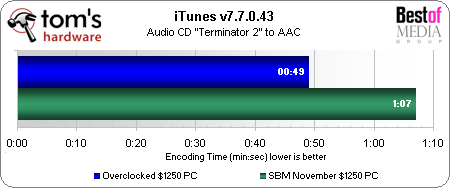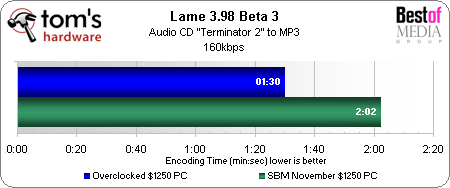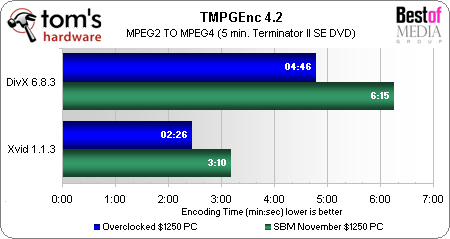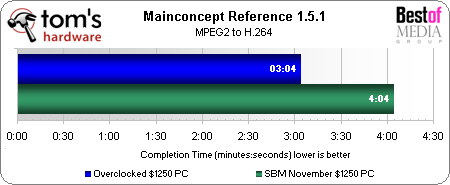System Builder Marathon: $1,250 Enthusiast PC
Application Benchmarks: Media Encoding

Our media encoding benchmarks usually reflect our overclocking efforts very consistently as encoding is all about CPU-heavy calculations.
As usual, we’ll start with iTunes and see how long it takes to encode a 500 MB wave file into the AAC format:

iTunes shows a 37% increase in encoding speed, somehow beating out our 35% overclock by a couple of percentage points. We’re starting off strong, so let’s check out how Lame audio encoding fares with the same file, converting it to MP3 instead of AAC.

The result is, of course, similar: a 36% speed increase in encoding the file this time around.
We move now from audio encoding to video encoding applications, some of which have demonstrated bottlenecks in performance not completely attributable to CPU clock speed, but occasionally more in line with multi-threading optimization. First off, let’s scrutinize the conversion of a video file into both the DivX and Xvid formats using TMPG:

When you average these results out, you see a 31% speed increase over the stock CPU clocks. Not too shabby, and certainly within the realm of our overclock, although it should be noted that both applications have achieved slightly different performance increases from the overclock.
We now test video encoding from MPEG2 to H.264 using Mainconcept:
Get Tom's Hardware's best news and in-depth reviews, straight to your inbox.

A similar result to be sure: a 33% performance increase with the overclock. We have seen that encoding performance closely follows clock speed increases. Now, let’s examine 2D and 3D graphics benchmarks.
Current page: Application Benchmarks: Media Encoding
Prev Page Benchmark Results: Synthetics Next Page Application Benchmarks: 2D and 3D RenderingDon Woligroski was a former senior hardware editor for Tom's Hardware. He has covered a wide range of PC hardware topics, including CPUs, GPUs, system building, and emerging technologies.
-
WINTERLORD yea for that kind of money i would definatly be buying a entry lvl core i7 920 setup with ddr3 1333, 3gb memory. for gaming, maybe go with a 4870, but in my opinion a geforce 260 or 280 would be better, because it's powerfull with games and you can use CUDA. cuda is really taking off tmperg has a video encoding software withat uses the graphics card, and it gives you a +400% to rendering video and such. such as bluray- and DVD encodingReply -
theblade Nice build, good performer for the price, looking forward for the next article.Reply
It would be great to see an article in which several options of cooling would be compared to see which one gives a better overclock using the 8500 or 8600, including air and water cooling, this chips are awesome to do some OC. -
craig hallworth I'd be interested to see the GTX 260 (216) in SLI on the mid range build as the price for two is a bit more but still comparable with the 4870x2 and, from what I've read, should be more powerful than the radeon card.Reply
I don't know that you can consider the i7 a mid range platform when you have to spend ~350-400 bucks on the montherboard alone. I'd certainly use the i7 for the high end build though.
Thank you for your efforts. -
gallesol There are some of us who who receive a great deal of disconfort thinking of Intel as the only microprocessor manufacturer around. If for no other reason than to maintain some competition in this critical industry, please include an AMD based system.Reply -
marraco ...Reply
It look like you never waited crysis to load.
... and the power is far overkilling. It could be saved money on it -
Rifte Would of liked to see a direct comparison to the $625 build in all but the gaming benches. Is the more expensive mobo, ram, cpu combo worth it?Reply
Put the 4850 in the $1250 system then do some game benches or put the 4870x2 in the $625 system. -
Rifte $276 vs $467 for a 5-8% increase in performance?Reply
direct comparison
$1250 $625 %dif
Itunes 00:49 00:52 +6.1%
lame 01:30 01:36 +6.6%
TMPGE 04:46 05:04 +6.2%
Xvid 02:26 02:52 +17.8%
Mainconcept 03:04 03:17 +7.1%
Photoshop 01:12 01:15 +4.2%
3d Studio 00:45 00:49 +8.8%
Average +8.1%
Price diff for cpu,ram,mobo +69% -
3lvis For the next build I would like to see an i7 920, a gigabyte extreme x58 board, 6GB of Gskill DDR3 1333 PC 10666 with cas 7, a pair of 4870x2's water cooled and 2,3,and 4 64GB Gskill SSD's in raid 0. As the price of SSD's comes down, my interest in how a bunch of them in Raid 0 perform goes up(inversely proportionally).Reply -
radguy I think I would have picked up a cheaper p45 board and used the extra cash to pick up a couple of fans to help with the cooling issues. Otherwise pretty nice gaming build. I don't know if Enthusiast is the name I would use with 530 bucks going to graphics but thats me. Appreciate the info. Nice to kinda be able to compare the E2180 E5200 E8500 and Q6600 all at stock and oc'ed. Core i7 would be nice to add to the list as well as phenom in your upcoming builds.Reply